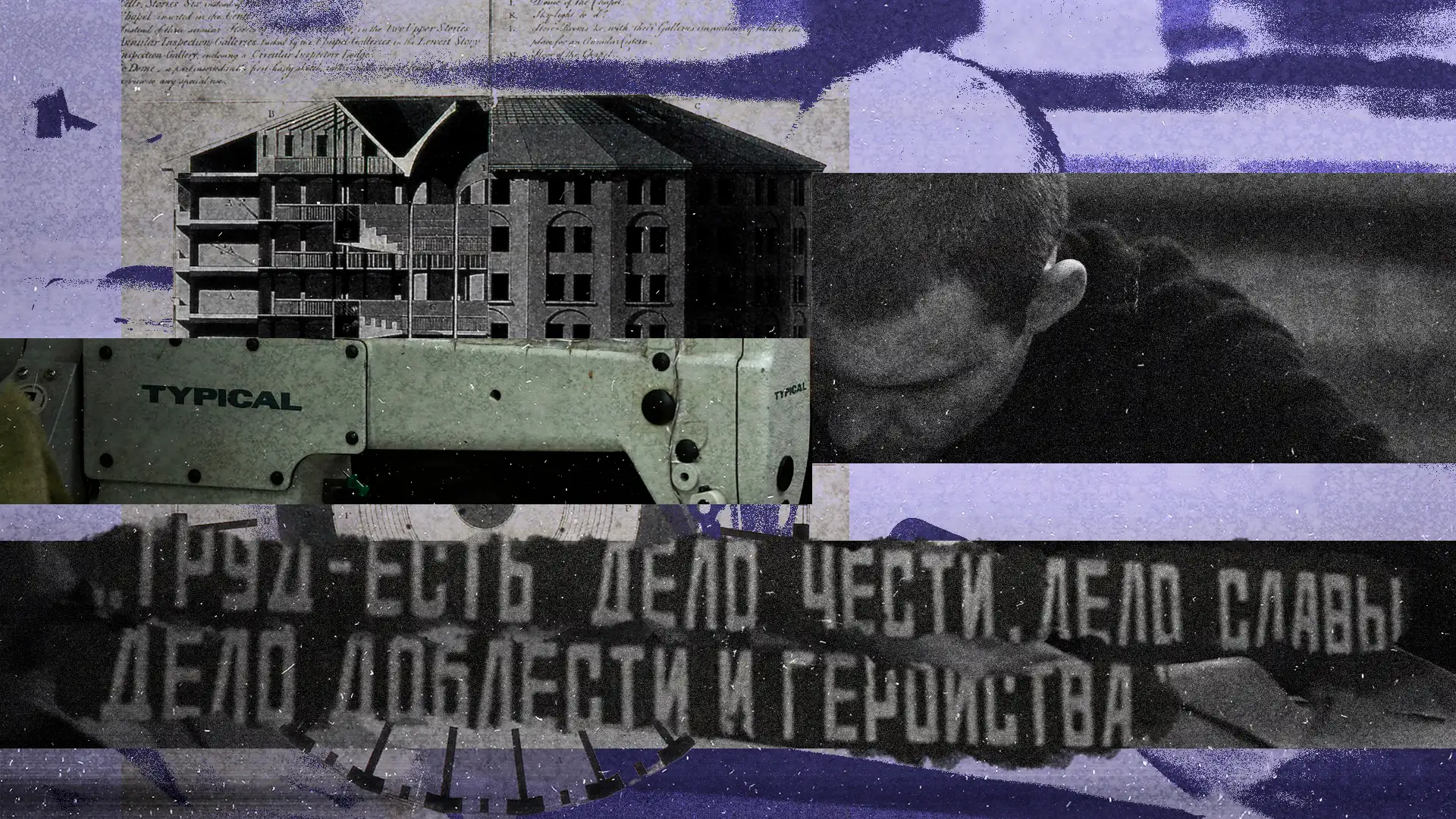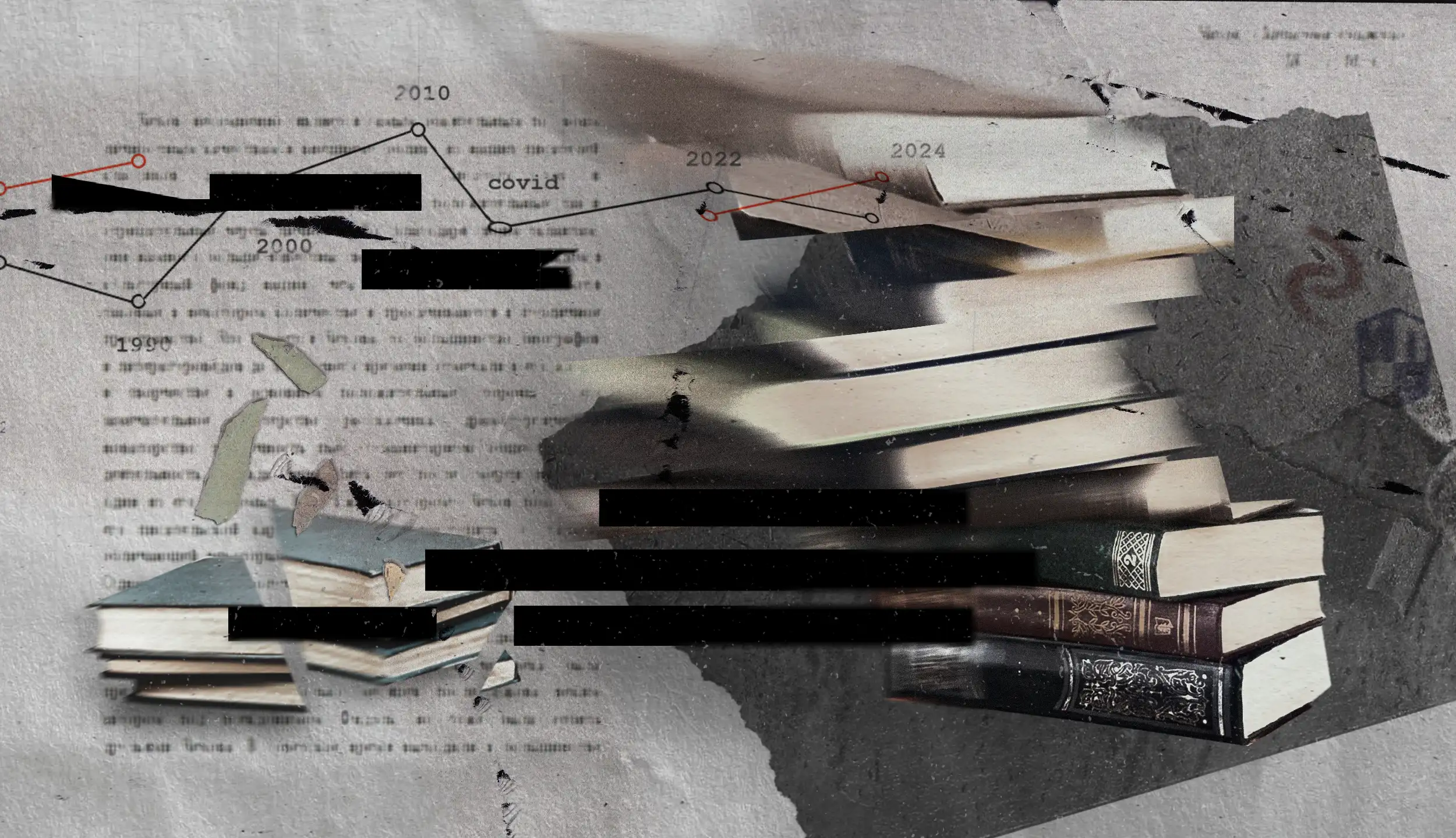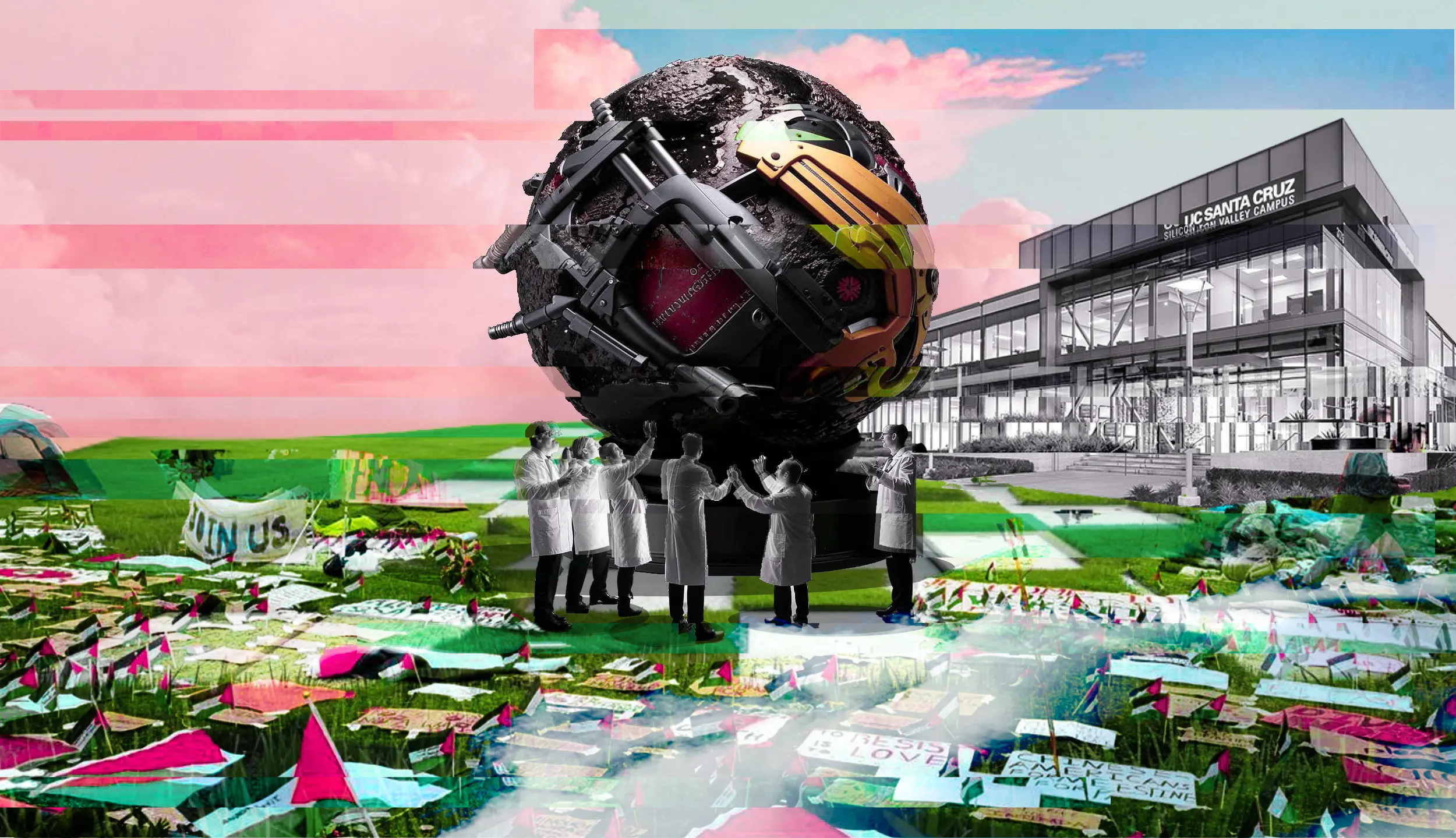Behind a glass vitrine in the main hall of the University College of London there sits a dummy with a head made of wax, dressed in a suit, with a wide-brimmed straw hat. The hands are gloved to hide the bones, while the legs squeeze together a wooden cane.
This is Jeremy Bentham, whose original head has long since begun to rot, and is thus stored separately. In 1970, one of the students of the college stole it, demanding a ransom of a hundred pounds. The college agreed to pay ten. The head was returned.
Bentham is an English philosopher, jurist and the creator of the project for an ideal prison known as the “Panopticon.” His sketches for the structure show a cylindrical building split by glass partitions into cells, fully open to the gaze. In the center, there is a tower, from where the overseer watches, hidden from sight. The imprisoned are always visible, and cannot anticipate when they are being watched. Perhaps there is no overseer in the tower at all.
The feeling of constant surveillance and control is designed to subjugate the wills of the imprisoned, making it possible to re-educate them. Bentham’s ideas had a major influence on the French philosopher Michel Foucault. In Discipline and Punish, his monumental work on the prison as the highest expression of power, he uses the panopticon as an illustration for the basic functioning of all power structures: both constantly in sight and unreachable for inspection.
In the same book, Foucault cites Nikolaus Heinrich Julius, a major reformer of the Prussian penitentiary system: “the prisoner who, on entering the establishment, was an inconstant man, or one who was single-minded only in his irregularity, seeking to destroy his existence by the variety of his vices, gradually becomes by dint of a habit that is at first purely external, but is soon transformed into a second nature, so familiar with work and the pleasures that derive from it, that, provided wise instruction has opened up his soul to repentance, he may be exposed with more confidence to temptations, when he finally recovers his liberty.”
Various thinkers disagreed regarding prison labor. Some considered it primarily a form of punishment. Others, conversely, saw labor as a “softening of punishment” and an opportunity for the convict to learn a trade, so as to support themselves and a family after being freed. Those who considered indolence and sloth to be the cause of criminality declared that prison labor transforms criminal-wastrels into worthy members of society.
The productivity of this kind of labor is low, bringing only limited economic value. But then, generating value is not its main goal. Labor here is a means of transforming a person into a mechanism that follows rules. The French politician Léon Faucher writes: “Work should be the religion of prisons. The machinery of society demands purely mechanical means of transforming it.”
Prison has several goals: condemnation, isolation, the prevention of recidivism, punishment and rehabilitation. Compulsory labor is both a punishment and a means of rehabilitation, and a sort of recompense paid by the prisoner to their society. However, prison labor is as often simply torture, pointless, senseless, and merciless.
Artistic reforging
“Harsh but useful labor — that is what the working class offers its enemy. It shows and proves to the convict that in order to live, he must become different, changed by being reforged through labor to benefit the whole country.”
This is a passage from the 1934 book The Stalin White Sea-Baltic Sea Canal (Belomorcanal), the collective effort of thirty-six Soviet writers who sang their praises of the labor of the condemned during the construction of the Belomor canal. One of these authors was Dmitri Svyatopolsk-Mirskij, a literary scholar with an unusual life story.
Born into the family of the interior minister of the Russian empire, he grew up friends with luminaries like Kuzmin and Gumilev, Akhmatova and Mandelshtam. During the Civil War he fought in the White Army, and was even briefly the commander of a division. In 1920 he emigrated and spent the next eleven years in London, where he became interested in Eurasianism and later Marxism, after which he joined the British communist party. In 1932, the former count, descendant of Catherine II and expert on Russian literature returned to the USSR, if you can call moving to a completely new and different state a “return.”
The summer of the following year, Svyatopolsk-Mirskij joined a hundred other Soviet writers on a ship taking them to the White Sea-Baltic Sea Canal, in order to meet the “canal-army.” The meeting was conducted under the watchful eyes of the OGPU (the special branch of government security of the USSR—moloko plus) and without crossing the boundary of the ship’s railing. Before the voyage, many of the literary activists were taken to a reception at the Leningrad “Astoria” hotel, and treated to caviar, cognac and chocolate. That same year, in 1933, several million Soviet citizens would die of hunger. Among them, 10% of the builders of the White Sea-Baltic Sea Canal (and this according to official statistics).
The Canal became the first of the “great projects” built exclusively by convicts. More than a hundred thousand prisoners of the White Sea-Baltic Sea labor camp, a subsidiary of the greater GULAG system, worked in subpolar conditions without the necessary equipment and with significant material deficiencies: for example, using water lock gates made from wood, rather than metal, for the first time in history.
Stalin did not like the canal named in his honor: it seemed thin and shallow, only three and a half meters deep at that point. According to contemporaries, the Great Leader called the canal “pointless and useful to no one.” According to official statistics, the construction of the “pointless” Belomor canal killed more than twelve thousand prisoners. Some historians believe the true number of the dead to be more than eighty thousand.
The book published after Mirskii’s voyage sang the praises of Comrade Stalin, the watchful secret police, and the “reforged” prisoners. “Reforging” described the process of transforming thieves, wreckers and counterrevolutionaries into worthy Soviet citizens via compulsory labor. “The idea behind the construction of Belomor is deeply socialist. The labor of the condemned is invested with a powerful political meaning: don’t merely serve your time, help build a society where there will be no crime!” wrote the authors.
Only a few years later they themselves became wreckers, counterrevolutionaries and spies. Practically the entire print run of the book was destroyed. The Soviet Union threw the literary workers off their ship.
Sviatopolsk-Mirskij was also accused of espionage and sentenced to eight years of corrective labor. He was not in any danger of “reforging”: with the beginning of the Great Terror this concept gradually disappeared from the rhetoric of the authorities. The enemies of the people didn’t need to be re-educated — it was enough to liquidate them. In 1939, Beria called Mirskij back to Moscow for additional inquiries, but he was already dead and had been for several months, having died in a camp near Magadan.
Altogether, according to the data collected by “Memorial International,” in the entire history of the Soviet Union, between 4.7 and 5 million people were arrested for various political crimes. Approximately a million out of those arrested were consequently executed.
In 2023, the Belomor canal turns ninety. It survived the Second World War, a major repair and reconstruction, and the collapse of the Soviet Union. The post-Soviet world doesn’t seem to need the canal — ships rarely traverse it. A growing network of roads and railroads made the canal redundant. Most Russians today associate the word “Belomor” with the cigarette brand, rather than with the reforging of criminals.
Simple Movements
Peloton advertises their signature treadmill as bringing you closer to your dreams. In an ad, an instructor, speaking with a strong British accent, announces: “Running for me is the highest expression of freedom!”
According to Google Trends, the number of people who looked up the word “treadmill” significantly increased after January 2020, as the world settled into quarantine. Because of the pandemic, the morning run was replaced with a run in-place, and the popularity of treadmills skyrocketed.
However, the “treadmill” wasn’t always a modern device for cardio training. Originally, the “treadmill” is a torture device used in the prisons of the British empire. In Russian, it was known as the “stepping wheel.” It could be used to grind grain or pump water, but for the condemned it was from the start designed as a Sisyphean task — the prisoners ground air. Only later was the device turned towards making something other than blood and sweat.
Victorian treadmills looked like huge, metal-bound wheels, with in-set steps, split with wooden partitions into twenty cells. Within each cell, the convict walked the steps in absolute silence, facing a blank wall. They were to walk the steps for ten hours, climbing and climbing under the watchful gaze of the overseer. If the convict had a bad heart, they were likely to die on the wheel.
The stepping wheel was not the only engineering feat developed by British jailors. An 1851 engraving shows the prisoner standing on a board upon which also stands a column topped with a wooden box with a handle. The prisoner spins the handle with their hands while looking through the barred window of his cell. The box hides four scoops submerged in sand which the prisoner must turn with great effort, rotating the scoops through the sand. In a six-hour workday the condemned had to turn the handle fourteen thousand times, each turn supposedly taking 1.5 seconds. The overseer could purposefully tighten the screw to increase the resistance when turning the handle. This work was absolutely pointless.
The goal of such a punishment was preventing recidivism. It was believed that after experiencing it, the prisoner would never again want to return to prison. Additionally, as a result of prison reforms, prisoners started to be provided with food and bedding. Previously, the provision of both food and blankets was the responsibility of the convict’s relatives. The new conveniences had to be balanced with suffering, to exclude the possibility of the poor purposefully committing crimes to get food and shelter in prison.
Oscar Wilde was one of the victims of the stepping wheel. After being condemned and sentenced for “gross indecency” (homosexuality: moloko plus) he was forced to work on the wheel at the Pentonville Jail. Never recovering from prison conditions, he died three years after his release at the age of 46.
Because you are black…
The Thirteenth Amendment to the United States’ Constitution adopted in 1865 reads “Neither slavery nor involuntary servitude, except as a punishment for crime whereof the party shall have been duly convicted, shall exist within the United States, or any place subject to their jurisdiction.” After the abolition of slavery “except as punishment for crime” became a key loophole for recent slave owners. The exploitation of unpaid black labor never stopped. It just accumulated new institutions around it.
Brutally restrictive “Jim Crow” laws adopted throughout Southern states delimited the rights of people of color by vastly expanding the range of activities for which people could be imprisoned. The rights to choose your employer, travel freely, to own land or rent it, to bear arms, enter mixed marriages, vote or run for office were all legally restricted. Simply leaving was rarely an option either: many northern states either curbed or banned entrance to people of color or mixed ancestry, ostensibly to keep competition low for their own workers.
Homelessness and loitering became criminal. You could end up in jail for walking on a lawn, speaking loudly in front of white women, or spitting on the pavement. Those who couldn’t pay the punitive fines were sent to compulsory labor, with the pay earned going towards the fine. A person sentenced to a month of compulsory labor would also have to pay for the labor of the sheriff and the court secretary. Since the condemned likely also had to pay for rent and food and other needs, paying out the debt became impossible, leading to new charges being added — and so a month’s punishment stretched into many months, or even years.
Under these circumstances, the state had to spend to provide the imprisoned with food and shelter. However, a new idea for making prison labor maximally profitable for both the state and private corporations emerged: the convicts could be rented out. They could extract rubber, build roads, cut lumber and work on sugar plantations.
The “renters” ranged from small farmers to major coal, railroad and steel corporations. They were responsible for providing food, clothes and medical care to the convicts while housing them, and paying rent to the state. In return they received a virtually unpaid labor force, virtually devoid of rights. Many of the required necessities were never provided. The convicts living in corporate barracks drank dirty water, and suffered from tuberculosis and malaria. One out of every ten people condemned to compulsory labor died. After the introduction of this system, Southern states functionally stopped building new prisons.
In 1890, Tennessee mine workers mounted an armed rebellion called the Coal Creek War. Workers demanded payment in dollars rather than company scrip. The Tennessee Coal, Iron and Railroad Company (TCI) which owned the mines, refused these demands. The corporation stopped work in one of the mines and instructed the workers to sign a contract forbidding them to unionize. The workers refused.
Several months later, the mine reopened, but without its original workers. Convicts took their place, rented from the Tennessee prison system to the corporation. The government of the state did not support the striking workers: governor John P. Buchanan simply sent armed state troops to Coal Creek.
The coal workers raised arms in revolt. For a year and a half, two thousand workers clashed with state troops, burned prison buildings and released hundreds of prisoners, liberating them from compulsory labor. The miners provided prisoners with food and civilian clothing, told them not to break the law anymore, and put them on trains back to Knoxville, from where many of the convicts originated.
More than 500 protestors were arrested, 27 were killed. The Coal Creek war became a part of American folklore, including the protest music of the Appalachians: “The corruption of Buchanan/Brought the convicts here/Just to please the rich man/And take the miner’s share”.
Despite the miners’ defeat, it was the Coal Creek war that in 1896, lead Tennessee to become one of the first southern states to abolish the practice of renting out convicts. Neighboring Alabama only abolished the practice in 1928, the last state to do so.
Between 1869 and 1919, Alabama’s prison population increased 650%. At the end of the 19th century, 73% of the state’s annual income came from renting out convicts to private companies; 85% of these convicts were black. One such company was the very same Tennessee Coal, Iron and Railroad Company which moved the bulk of its operations from Tennessee to Alabama.
In 1911, 125 leased convicts died in an explosion at TCI’s Banner Mine in Alabama. Of the dead, only five were white. Immediately after the dead were buried, new convicts came to remove the rubble.
It was only after this accident that Alabama’s governor adopted a law mandating safety standards in coal mines.
I’m lovin’ it
Black screen. Tense music. A lamp switches on with a loud click. A man’s form appears outlined in the glare. The man’s face comes into the light: tan and wrinkled, with a furrowed brow. He holds a small vial in his hand. “That is crack, rock cocaine” he says softly “This can kill you, and if you’ve got to die for something this sure as hell ain’t it.” The vial is filmed in close-up. Underneath, a warning reads “Don’t even try it! The thrill can kill!”
An elderly woman with а tidy haircut appears near the man. She is wearing a golden necklace, earrings and buttons, her elegant jacket collar is neatly ironed. “The thrill can kill” she says accentuating the word “can”, “Say ‘No’ to drugs and say ‘Yes’ to life”.
The man is Clint Eastwood, the film star famous for westerns. The woman is Nancy Reagan, then First Lady of the United States. The video is part of the social campaign “Just Say No”. The campaign began with Nancy’s speech in one of Oakland, California’s primary schools in 1982. A young girl asked the First Lady what she should do if someone offers her drugs. “Just say no,” replied Reagan.
In the following years, the antidrug campaign under the slogan “Just Say No!” went nation-wide. The so-called “War on Drugs” made the punishments for the possession or distribution of illegal substances much harsher, while the number of convicts grew rapidly.
According to 2022 data, the United States imprisons more people than any other country on earth: 25% of the entire world’s population of prisoners are currently in the United States. Much like in the Jim Crow era, 86% of those held within the United States justice system are imprisoned for non-violent crimes. The “War on Drugs” accounts for the majority, with 46% of the total prison population of the United States convicted of drug-related offenses, according to 2021 data.
In the thirty-five years since Nancy Reagan’s 1982 speech, the number of American convicts has more than tripled. The growth of the prison population is profitable for the government, corporations and the prisons themselves. Contracts between private prisons and local authorities mandate that cells be kept full to a set level (in some states this is 70%, in others 100%), to avoid the state having to pay rent on empty beds. The people occupying these cells are no longer dying in coal mines, but they still work for their freedom, translating dictionaries into Braille, tailoring military uniforms and weapons, building furniture for student dormitories, knitting mattresses, growing corn, fighting forest fires, and manufacturing electronics for the Defense department. In the prison holding Charles Manson, the convicts make knick-knacks for the prison gift shop, while in Michigan, the whole state’s license plates are made by convict hands.
Just as in Russia, in the United States prisoners run phone support services, only in the US this activity is perfectly legal, and some prisons even host call centers where convicts field calls for the prison and for private companies alike. Michael Bloomberg, the owner of the Bloomberg media conglomerate and former New York City mayor used such call centers in his election campaign for president, when he ran in 2019 — the convicts called potential voters to garner support.
Convict labor is not only used by grotesquely rich individuals, but by major corporations including McDonald’s, IBM, Boeing, Intel, Victoria’s Secret, Starbucks, Microsoft, Nike and Honda.
Although convicts no longer die in droves in giant construction projects or punitory stepping wheels, the prison system has not become more just. American prisoners receive just 5% of the millions of dollars in profits that their labor generates. In Alabama, Texas, Arkansas and Georgia they receive nothing for their labor. Women imprisoned in Colorado have to save their wages for two weeks in order to be able to afford a box of tampons. Despite daily labor in unsafe conditions they leave prison without a penny in their pocket. The people making McDonald’s uniforms behind bars make less than the employees yelling “Next Customer!”
This article was first published in Prison, issue 8 of the moloko plus almanac.







